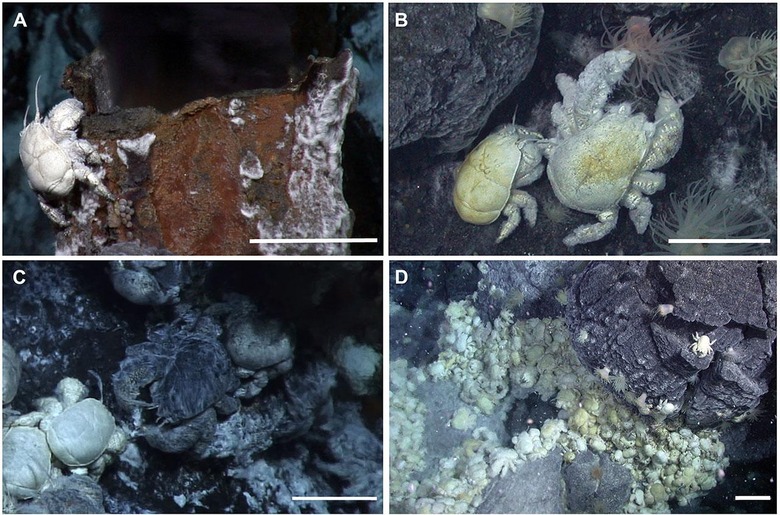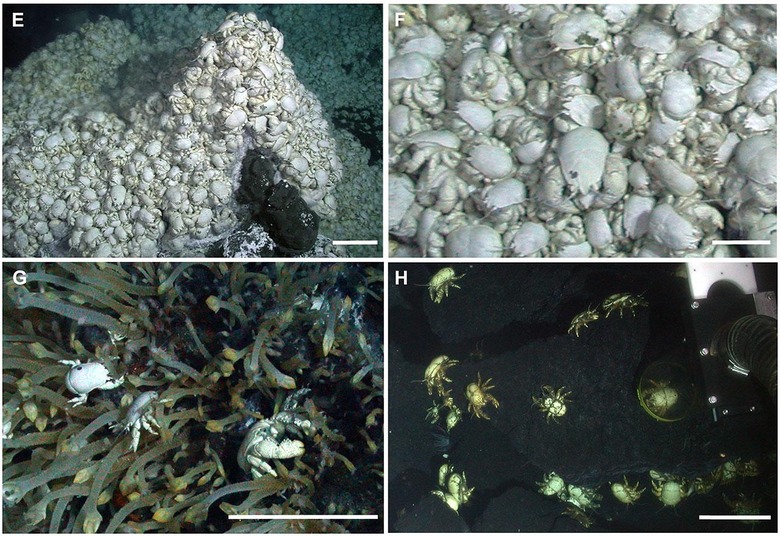"The Hoff" Yeti Crab Farms Food From Its Own Hairy Back
The blind Yeti Crab "Kiwa tyleri" has been revealed this week in a paper describing it for the first time ever. This lovely white-colored creature lives in the Antarctic while its relatives live in the heat, living in frigid temperatures while its closest relatives live near hot thermal vents in the ocean's floor. One of the several abnormal features of this crab is its ability to farm its own food. Instead of heading out into the wilderness of the ocean to snap up smaller fish, this crab nabs bacteria from its own back.
This Kiwa tyleri yeti crab is the first known to exist in the Southern Ocean, living there right off the side of Antarctica. There it's been photographed and observed by scientists for the past several years. A study began in 2010 that's just being published now, showing the crab to the world for the first time ever.
These crabs are fairly small. Scientists have estimated that as many 600 yeti crabs have been spotted living in a space of a single square meter. They cram in together to live in the heat near vents like the one you see at the head of this article – this is a vent nicknamed "Carwash" by the crew studying this animal.

ABOVE: A) Individual male Kiwa tyleri at the orifice of a "black-smoker" fluid exit on the "Dog's Head" Chimney complex [1,6], E2 vent field; B) Female (left) and male (right) on the lower part of the "Dog's Head" chimney complex; C) "Kiwa B" assemblage (left) adjacent to "Kiwa A" assemblage (right) at the "Black & White" chimney at the E9 vent field; D) "Kiwa B" assemblage "Crab City" at the E2 vent field; Scale bar: 5cm (A,B,C), 10CM (D)
It's the hair (setae) on this creature's body that gives them the ability to have a lovely farm where bacteria grow and can be harvested for consumption.
What a neat way to eat.

ABOVE: E) "Kiwa B" assemblage at the "Black & White" chimney at the E9 vent field; F) Zoomed in section to show the dense multilayer aggregations of the "Kiwa B" assemblage at the "Black & White" chimney, both male and female individuals can be identified from chela dimorphism; G) Small individual Kiwa tyleri associated with the "barnacle assemblage" at the "Black & White" chimney; H) Brooding females away from the influence of direct fluid flow at "Anemone Field" E2 vent field; note: ROV slurp gun visible. Scale bar: 5cm (G), 10 cm (E,F,H).
In addition to hair on its back, this Kiwa tyleri yeti crab also has hair on its chest – it's underside. Because it has hair on its chest where its cousins do not, scientists have nicknamed this crab the "Hoff crab."
That's a reference to David Hasselhoff, the hairiest-chested of all the 1980's television superstars. Have a peek at Kung Fury to see where Hasselhoff is today. His chest hair will never die.
Above you'll see a very special moving image we've created showing The Hoff singing his praises for The Hoff. You're welcome.
You can learn more about this unique yeti crab in the scientific journal PLOS One. There you'll find the paper "Adaptations to Hydrothermal Vent Life in Kiwa tyleri, a New Species of Yeti Crab from the East Scotia Ridge, Antarctica" by authors Sven Thatje, Leigh Marsh, Christopher Nicolai Roterman, Mark N. Mavrogordato, and Katrin Linse. The paper can be found with code DOI: 10.1371/journal.pone.0127621 as of June 24th, 2015.
